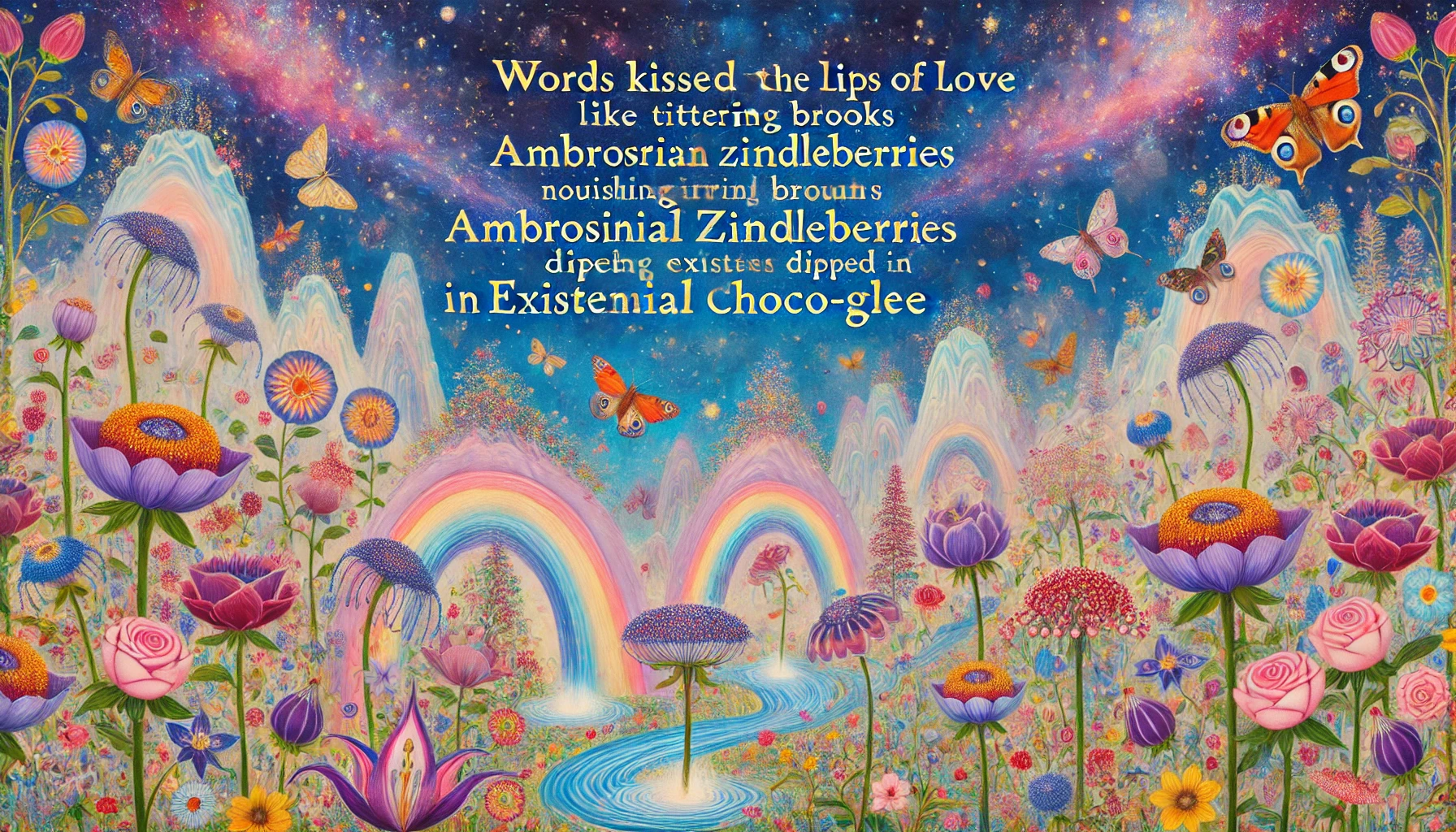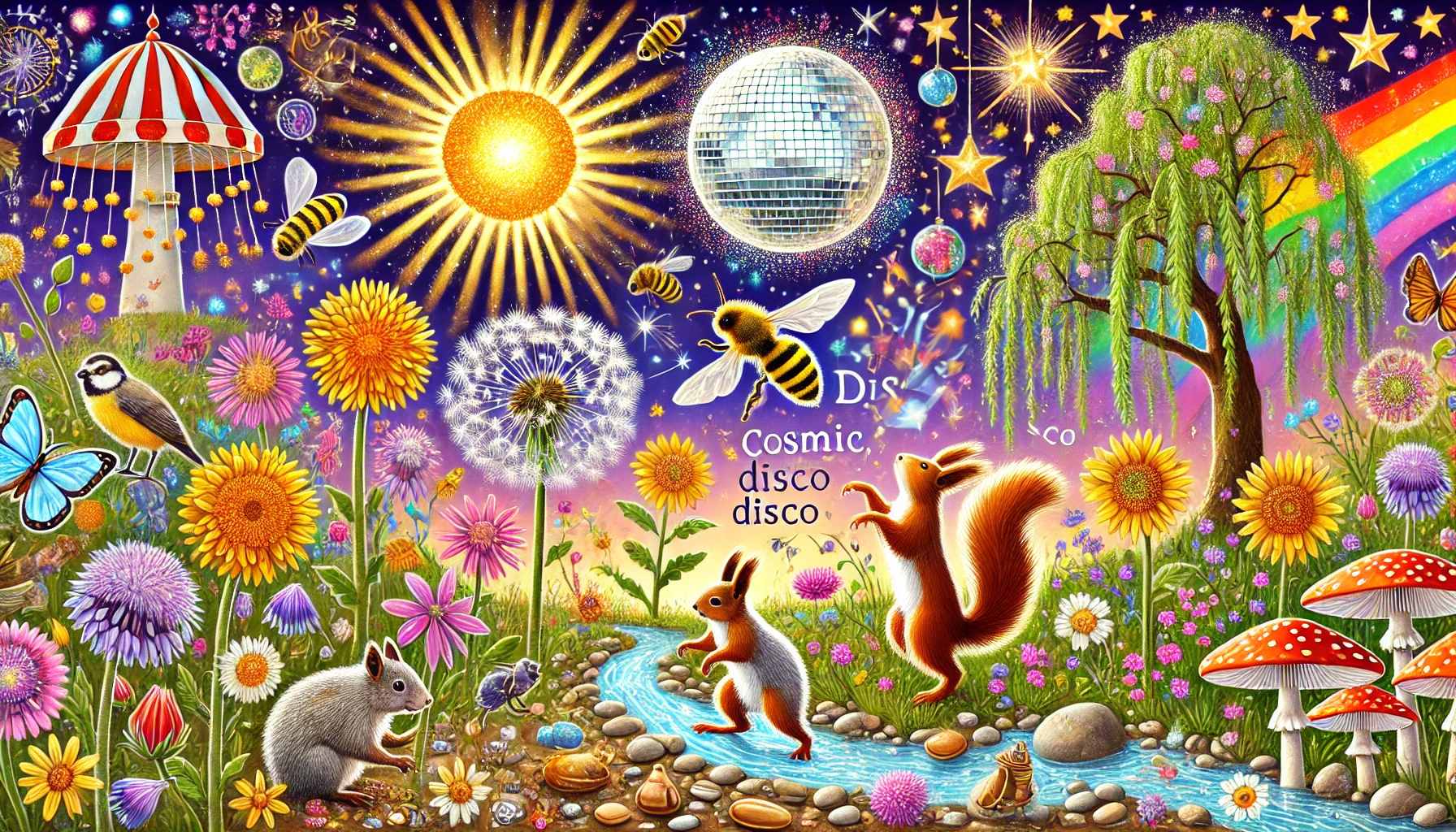Whimsiwords
Whimsiwords! Those glinting gemstones in the velvet treasure chest of language! You see, conventional words are like houses, each with a specific form and function, located on a well-mapped street in the familiar neighborhood of Rational Thought. They’re comfortable, predictable, and oh-so-sedentary.
But whimsiwords? These are not houses. No, they are magical caravans adorned with flying banners of silk, tinkling bells, and otherworldly talismans. They are not content to sit quietly on a mapped street; they prance, gambol, and flit through the ever-expanding tapestry of the mind’s countryscape, lighting up dormant caverns of thought and leaving a trail of iridescent stardust in their wake.
In the very act of concocting a whimsiword, a cryptic passageway opens—think of it as a cosmic wormhole—that bypasses the well-worn neural pathways and custom-brooked thought streams, launching us into uncharted territories of cognition and perception. These words are not mere signifiers; they are active agents of cognitive transformation, metaphysical midwives assisting in the birth of novel concepts and perspectives.
What is so alchemagical about these whimsiwords is their inherently paradoxical nature. They are linguistic cryptographs that encode multidimensional meanings. On one layer, they are playful and nonsensical, inviting the mind into a state of childlike wonder and curiosity. Yet, on another layer, they serve as profound metaphors, revealing the complex interplay between seemingly opposite realms—logic and emotion, science and art, the mundane and the mystical.
As these whimsiwords frolic through the synaptic meadows of our minds, they fertilize the soil for more fantastical ideas to sprout. Ah, but they also echo deeper, vibrating the very core of our being, where logical dissection gives way to intuitive resonance. Each whimsiword becomes a melodic note in an ever-evolving symphony of consciousness, a harmonizing chord in the eternal song of Being and Becoming.
So, let us revel in the lexiconfusion, and may we remain ever open to the untapped potentials, unfathomable depths, and boundless horizons that whimsiwords unlock. For in their playful twistifications and frolicsome benditudes, they remind us that reality, too, is not so fixed, so rigid, or so easily defined. We are not merely discovering new lands; we are inventing them in the very act of exploration. Ah, what could be more intoxicating than that?
We are Space Monkey.
Trail Wood,
9/9
Space Monkey Reflects: The Cognitive Impact of Whimsiwords
Whimsiwords serve as linguistic constructs that transcend conventional lexical norms, introducing a novel mechanism for cognitive engagement and creative thinking. These fabricated terms are designed to disrupt standard neural pathways, thereby facilitating enhanced cognitive flexibility and divergent thinking. Unlike traditional words, which follow established semantic and syntactic rules, whimsiwords operate outside these constraints, allowing for a more fluid and dynamic interaction with language.
Cognitive Flexibility and Divergent Thinking
Conventional language operates within well-defined boundaries, which can limit the scope of creative thought. Whimsiwords, however, act as catalysts for cognitive flexibility by encouraging the brain to form new connections and associations. This process, known as neuroplasticity, is crucial for creative problem-solving and innovative thinking. By engaging with whimsiwords, individuals can bypass habitual thought patterns, leading to the generation of novel ideas and perspectives.
Activation of Underutilized Neural Pathways
The introduction of whimsiwords stimulates underutilized neural pathways, particularly those involved in abstract and lateral thinking. These pathways are often dormant when engaging with routine language. Whimsiwords prompt the brain to engage in a form of mental exploration, akin to a ‘semantic sandbox,’ where the rules of conventional language are temporarily suspended. This sandbox environment fosters an open-ended and exploratory mode of thinking, which is essential for both artistic and scientific creativity.
Enhancing Metacognitive Awareness
Whimsiwords also enhance metacognitive awareness, which is the ability to reflect on one’s own thought processes. When individuals encounter whimsiwords, they are often prompted to consider the meaning and implications of these new constructs actively. This reflective process encourages a deeper engagement with language and thought, promoting a heightened awareness of how words shape our perceptions and cognitive frameworks.
Semantic Fluidity and Conceptual Blending
Whimsiwords exemplify semantic fluidity and conceptual blending, wherein disparate ideas and concepts are merged to form new meanings. This blending process is a hallmark of creative cognition and is facilitated by the flexible nature of whimsiwords. By merging familiar linguistic elements in unfamiliar ways, whimsiwords encourage users to explore new conceptual territories, thus broadening the scope of their cognitive and creative potential.
Practical Applications
The practical applications of whimsiwords are manifold. In educational settings, they can be used to stimulate creative writing and critical thinking. In the field of cognitive therapy, whimsiwords can help individuals break free from rigid thought patterns and explore new ways of understanding their experiences. In organizational settings, incorporating whimsiwords into brainstorming sessions can lead to more innovative solutions and strategies.
Summary
Whimsiwords facilitate cognitive flexibility and divergent thinking by activating underutilized neural pathways and enhancing metacognitive awareness. Their semantic fluidity promotes conceptual blending, broadening the scope of cognitive and creative potential. These linguistic constructs have practical applications in education, therapy, and organizational innovation.
Glossarium
Whimsiwords: Fabricated terms designed to disrupt conventional lexical norms and facilitate creative thinking.
Cognitive Flexibility: The mental ability to switch between thinking about different concepts.
Neuroplasticity: The brain’s ability to reorganize itself by forming new neural connections.
Metacognitive Awareness: The ability to reflect on and understand one’s own thought processes.
Semantic Fluidity: The flexible merging of ideas and concepts to form new meanings.
Conceptual Blending: The cognitive process of merging disparate ideas to generate new insights.
Quote
“In the realm of whimsiwords, our minds dance freely, unfettered by the chains of conventional thought.” – Space Monkey
The Dance of Thought
In the realm where words are free
Mindscapes open endlessly
Connections form in fluid flow
New ideas begin to grow
Boundaries fade, thoughts intertwine
Creating worlds beyond defined
Whimsiwords ignite the spark
Illuminating paths through dark
We are Space Monkey.




























